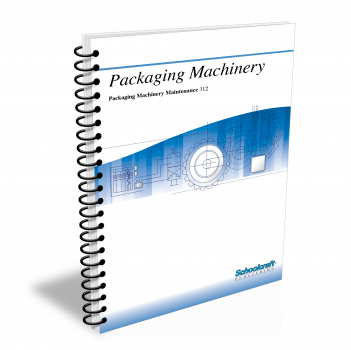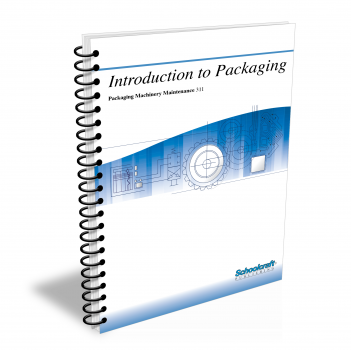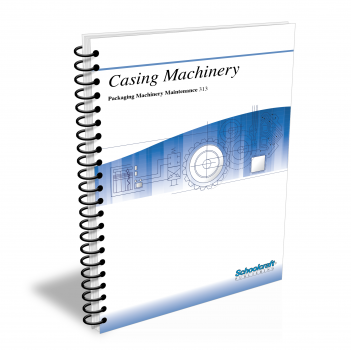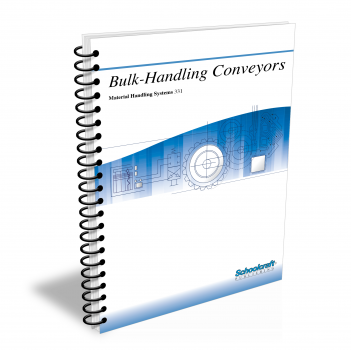Packaging Machinery

Course Number: 312
The Packaging Machinery textbook covers operating and servicing various types of packaging machinery. It describes different types of liquid filling machines, and covers positive displacement fillers, filling, and sealing machines, as well as volumetric filling machines and blister packaging machines.
Does your curriculum require additional topics not included in this textbook? Build a customized version of the Packaging Machinery textbook below.
Recommended Contact Hours – 20
Preview a Chapter
Available Supporting Material
- Table of Contents
- Exam Copies
- Suggested Titles
Table of Contents
Chapter 1: Gravity and Vacuum Filling
Topics: Gravity filling; Vacuum pump construction and installation; Vacuum, gravity, balanced, and submerged filling; Fill height and container control
Learning Objectives:
- List the main advantage and disadvantages of gravity filling and vacuum filling methods.
- Tell what kinds of vacuum pumps are commonly used in filling applications.
- Describe the construction and operation of vane and piston pumps.
- Compare and contrast vacuum filling, gravity/vacuum filling, balanced vacuum filling, and submerged vacuum filling.
- Explain various methods of fill height and container control.
Chapter 2: Bottle Filling and Capping
Topics: Volumetric filling; Auger feed pumps; Volumetric-displacement, constant-level filling machines; Counter-pressure filling; Capping; Sealing
Learning Objectives:
- List some of the factors considered when selecting a bottle filling machine.
- Explain the operation of, piston-type, auger, volumetric-displacement, and constant-level filling machines.
- Describe the various kinds of bottle capping and sealing.
- List the major maintenance requirements of liquid filling machines.
Chapter 3: Pressure Liquid Filling
Topics: Indexing pressure fillers; Indexing container control; Continuous motion, rotary pressure fillers; Filling nozzles; Filling control
Learning Objectives:
- Name the most important advantage of using positive displacement pumps on pressure filling machines.
- Name the two classifications of pressure fillers.
- List possible causes of filling inaccuracies.
- Explain the importance of proper fluid velocity in filling machine operation.
Chapter 4: Aerosol Fillers
Topics: Aerosol container construction and valves; Propellants; Container, cold, and pressure filling; Safety testing; Drying; Capping; Accessories
Learning Objectives:
- Explain the concept of aerosol filling.
- Describe metal container and aerosol valve construction.
- Name and describe the two methods of aerosol container filling.
- Explain the operation of the individual stations in a filling line.
- Describe the process by which aerosol containers are safety tested.
Chapter 5: Bag Forming and Filling
Topics: Bag materials and construction; Bag forming; Film extrusion; Bag filling machines; Bag machinery maintenance
Learning Objectives:
- List commonly used bag materials and their typical applications.
- Explain the various bag constructions and related terminology.
- Describe the film extrusion method of bag forming.
- Explain the operation of bag filling machines.
- List the major maintenance requirements of bagging machinery.
Chapter 6: Pouch Filling
Topics: Pouch materials and control; Vertical filling machines; Horizontal and vertical pouch filling and modifications; Continuous motion fillers
Learning Objectives:
- Tell how pouch filling machines are classified.
- Name the three types of vertical seals made on vertical form, fill, and seal machines, and tell when each is used.
- Explain the vertical filling machine operating sequence.
- Name the two methods of classifying pouch filling machines that handle the film horizontally, and give advantages of each.
Chapter 7: Volumetric Filling Machines
Topics: Balance point measuring; Measuring by volume, weight; Intermittent motion fillers; Continuous motion, draw, and liquid volumetric filling
Learning Objectives:
- Give examples of products that can be handled by volumetric fillers.
- Explain how volumetric filling machines are identified.
- Describe the operation of volumetric filling machines.
- Describe the various methods of measuring products packaged on volumetric filling machines.
- Explain how liquid volumetric filling is controlled.
Chapter 8: Filling by Count
Topics: Filling by count; Flat plate and disk sorters; Column measuring; Electronic counting; Strip, blister packaging machines; Cottoning devices
Learning Objectives:
- Give examples of products that are commonly packaged by count.
- Describe three methods of counting product in a fill by count machine.
- Define the term strip packaging, name its two classifications.
- Give an example of a product packaged by each of the two strip packaging methods.
Chapter 9: Positive Displacement Filling
Topics: Controlling the fill; Automatic and manual filling machines; Timing control; Continuous motion filling machines; Rotary filling; Maintenance
Learning Objectives:
- Trace the positive displacement filling cycle.
- Name the kinds of pumps used to fill containers on positive displacement filling machines.
- Describe the controls associated with positive displacement filling systems.
- List important points in the maintenance of positive displacement filling machines.
Chapter 10: Blister Packing
Topics: Blister films and cards; Reducing blister failures; Test procedures; Seal examination and evaluation; Product compatibility; Blister forming and sealing
Learning Objectives:
- Define the term thermoforming.
- Describe the film and card materials commonly used in blister packing.
- Give several examples of problems that can cause blister failures.
- Describe the tests and evaluations performed on blister package seals.
- Tell what kind of film is most often used with inline blister forming machines.
Request Exam Copies
Exam Copies
Ready to see a copy of our textbooks? After selecting which textbooks you’d like to review for your course, you can submit your request by either logging in or creating an account so we know where to ship your exam copies. A representative from Schoolcraft will contact you to confirm and finish processing your request.
Exam copies are always free and yours to keep.
Selected Exam Copies
none selected
* Maximum of five copies can be ordered


